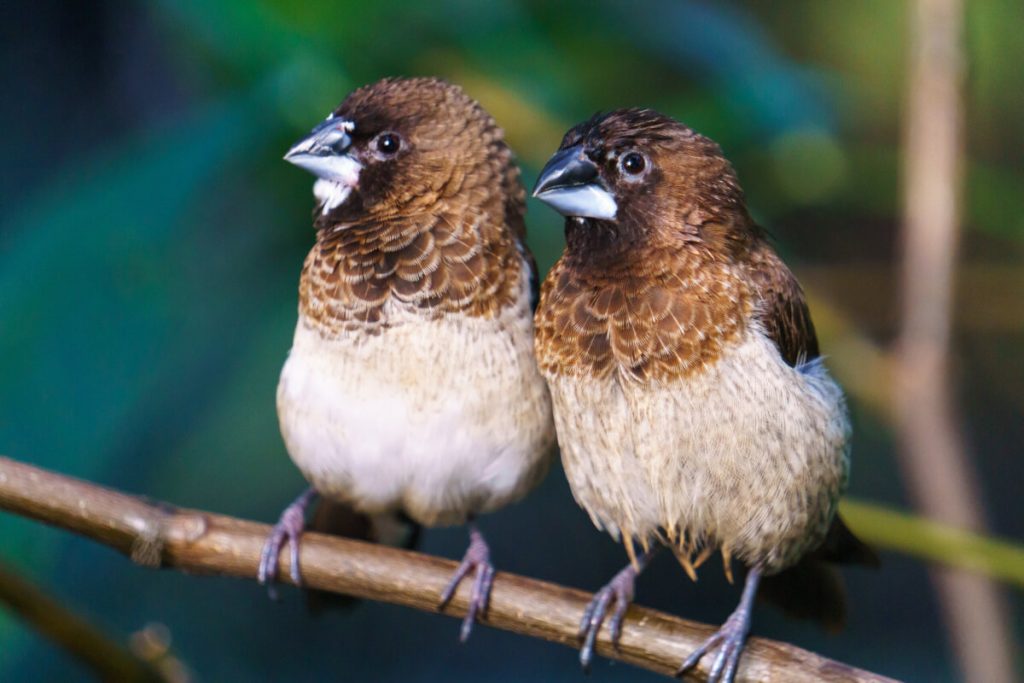

Two Bengalese finches, also known as Society finches. These are the birds examined in this study. (Dorota Photography/Shutterstock)
UNIVERSITY PARK, Pa. — Sophisticated birdsong follows strict grammatical rules, much like human sentences. But what happens when birds can’t hear themselves sing? A new international study of Bengalese finches suggests the answer could reshape our understanding of how all brains, even human ones, process complex sequences.
The study, published in the Journal of Neuroscience, reveals an important discovery about how birds maintain their songs. Bengalese finches, songbirds specifically chosen for their remarkably complex tunes, rely heavily on hearing themselves to maintain the intricate patterns in their melodies.
“Although much simpler, the sequences of a bird’s song syllables are organized in a similar way to human language, so birds provide a good model to explore the neurobiology of language,” explains lead author Dezhe Jin, associate professor of physics at Penn State, in a statement.
To understand how context shapes these songs, consider how we use words in English. As Jin points out, the phrase “flies like” could be part of “time flies like an arrow” or “fruit flies like bananas.” But “time flies like bananas” makes no sense; the meaning depends on what came before. Bengalese finch songs follow similar rules, with each syllable’s likelihood depending on what came before.
The research team analyzed songs from six adult male Bengalese finches, each capable of singing sequences of 7 to 15 distinct syllables. They developed a sophisticated mathematical approach called “partially observable Markov models.” This method was inspired by how generative models, like ChatGPT, analyze sequences, though theirs is a statistical method rather than a deep learning model. Just as language models analyze vast amounts of text to determine which words are likely to follow others, their model analyzed bird songs to learn which syllables typically follow others—while also capturing more complex, context-dependent transitions.


But there’s a key difference. While simple models might just learn that syllable A is followed by syllable B 80% of the time, the researchers’ model could capture more complex patterns like how the likelihood of syllable B coming after syllable A might change depending on what came before A. This is similar to how in English, the word that follows “bank” might depend on whether you previously mentioned “river” or “money.”
“Basic Markov models are quite simple, but they tend to overgeneralize, meaning they might result in sequences that don’t actually exist,” says Jin.
Starting with basic models that only looked at simple syllable-to-syllable transitions, the researchers gradually added complexity until they found the simplest version that could accurately reproduce each bird’s actual song patterns without generating sequences the bird never sang. It’s like finding the minimum set of rules needed to describe a bird’s musical “grammar.”
This modeling approach proved powerful enough that when applied to English text, it could generate sentences that were mostly grammatically correct. While not as sophisticated as ChatGPT, the fact that the same type of model could handle both birdsong and basic human language suggests some fundamental similarities in how brains organize sequential behaviors.
Each of the six finches in the study displayed its own unique song structure, with sequences ranging from 7 to 15 distinct syllables. Some birds showed more complex patterns than others, much like how some human speakers use more varied vocabulary and sentence structures than others. These individual differences could stem from variations in brain structure or differences in how each bird learned its song from its tutor.
When the researchers surgically removed the birds’ cochleas, the spiral-shaped part of the inner ear that enables hearing, the changes in their songs were both rapid and dramatic. Within just 2-4 days, the sophisticated patterns began breaking down. The birds could still produce their syllables, but the intricate rules governing how these syllables fit together started to unravel.
This deterioration was particularly evident at transition points in the songs where birds would normally make context-dependent choices about which syllable to sing next. Without the ability to hear themselves, the birds began making these choices more randomly, suggesting that ongoing auditory feedback is crucial for maintaining the song’s complex structure.


The findings have implications beyond just understanding how birds sing. They provide insights into how brains, both bird and human, process and produce complex sequences of behavior. The researchers’ modeling method proved so effective that it could even generate English sentences that were mostly grammatically correct, highlighting unexpected parallels between birdsong and human language.
Both birds and humans must learn their vocalizations early in life, practice them extensively, and rely on hearing themselves to maintain them. Both also organize their sounds into structured sequences that follow specific rules: grammar in humans and song syntax in birds.
While human language is obviously far more sophisticated than birdsong, the basic neural mechanisms controlling sequence learning and production might be more similar than previously thought. The fact that the same mathematical model can capture both bird and human vocal patterns suggests some fundamental similarities in how brains organize sequential behaviors.
The study also demonstrates the remarkable plasticity of the brain’s vocal control systems. The rapid breakdown of song structure after deafening shows how quickly neural circuits can change when deprived of sensory feedback. This finding could have implications for understanding how humans maintain speech patterns and how hearing loss might affect vocal control.
Looking ahead, the researchers plan to investigate how specific groups of neurons in the bird’s brain correspond to different syllables in their songs. Previous research has shown that different neurons activate when birds sing, but this new modeling approach suggests something more complex: even when a bird repeats the same syllable, it might be using different groups of neurons depending on the context.
This research also offers new tools for studying other types of animal vocalizations and behavioral sequences. The same mathematical approach could help decode the structure of other animals’ communication systems or even complex behavioral patterns beyond vocalization.
The research team’s method improves upon previous approaches by automatically finding the simplest model that accurately captures an animal’s vocal patterns. This automation reduces human bias in the analysis and could lead to more objective studies of animal communication across different species.
The study shows that maintaining complex vocal patterns requires constant sensory feedback, whether you’re a singing finch or a speaking human. While human language may be uniquely sophisticated, the basic mechanisms that allow us to organize sounds into meaningful patterns may have deeper evolutionary roots than we thought.
Paper Summary
Methodology
The researchers developed their models by analyzing recordings from six adult male Bengalese finches, first creating a baseline of their normal songs, then comparing these to recordings made 2-4 days after bilateral cochlear removal (surgical deafening). They used advanced mathematical models called “partially observable Markov models” that could capture complex patterns in how syllables were sequenced. Starting with simple models, they gradually increased complexity until finding the simplest version that accurately represented each bird’s actual song patterns without overgeneralizing. This process was fully automated to reduce human bias in the analysis.
Results
All six birds showed context-dependent syllable transitions in their normal songs, though the complexity varied between individuals. After deafening, the birds showed significant reductions in what researchers call “state multiplicity” – a measure of how much previous syllables influence upcoming ones. Their songs became more random, with weaker connections between syllables. The number of possible transitions between different syllables increased, but became less predictable. Birds also showed individual differences in how well they maintained song structure after losing their hearing.
Limitations
The study focused on just six adult male Bengalese finches, limiting how broadly the findings can be applied across different ages, sexes, or species. The analysis focused on simplified versions of songs (removing repetitions), which might miss some aspects of song complexity. The short timeframe (2-4 days after deafening) doesn’t reveal long-term effects. Additionally, while the mathematical models could reproduce song patterns, they can’t definitively prove how these patterns are encoded in the brain.
Takeaways
The research reveals that auditory feedback is crucial for maintaining complex song patterns in Bengalese finches. The rapid breakdown of song structure after deafening suggests that maintaining these patterns requires active sensory feedback rather than just memory. The study also demonstrates unexpected similarities between bird and human vocal learning, suggesting some shared neural mechanisms for sequence learning and production. The new modeling method provides an automated way to analyze complex behavioral sequences across different species.
Funding and Disclosures
This research was supported by NSF award EF-1822476. The research team included Jiali Lu, who earned a doctoral degree in physics at Penn State in 2023; Sumithra Surendralal, who earned a doctoral degree at Penn State in 2016 and is now at Symbiosis International University in India; and Kristofer Bouchard at Lawrence Berkeley National Laboratory. The funders had no role in study design, data collection and analysis, decision to publish, or preparation of the manuscript. The authors declared no competing financial interests.
Publication Information
This research appears in the Journal of Neuroscience, published in early 2025. The paper, titled “Partially observable Markov models inferred using statistical tests reveal context-dependent syllable transitions in Bengalese finch songs,” was received in March 2024, revised in October 2024, and accepted in December 2024. The study builds upon previous research on birdsong structure and vocal learning, offering new insights into how the brain processes and produces complex behavioral sequences.








